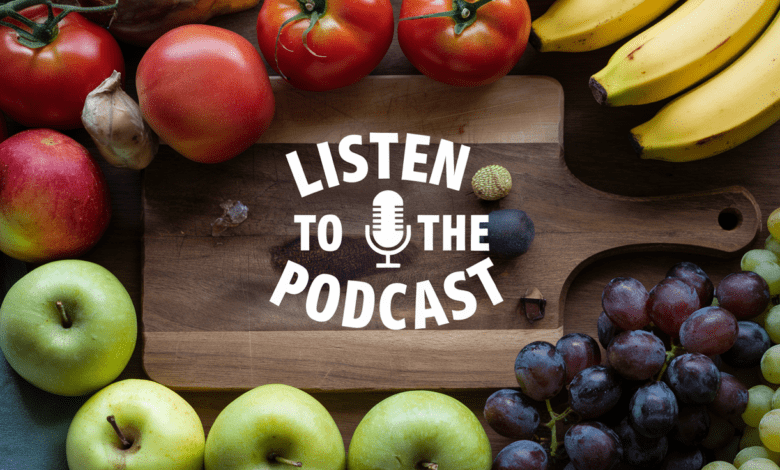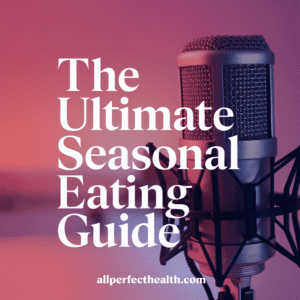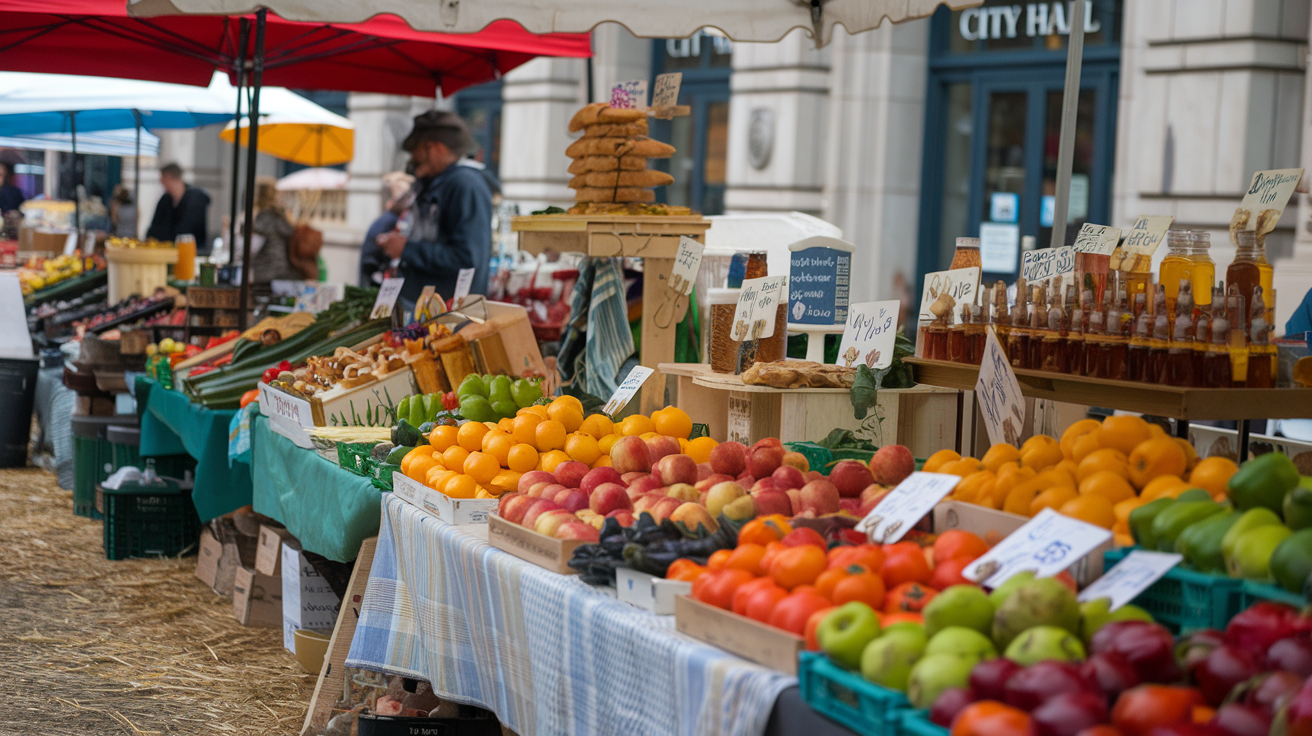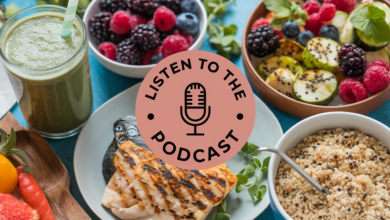The Ultimate Seasonal Eating Guide: Nourish Your Body Year-Round

The Ultimate Seasonal Eating Guide: Nourish Your Body Year-Round
Welcome to our guide on seasonal eating! This approach to nutrition helps you eat the freshest, most nutritious foods throughout the year. Seasonal eating means choosing foods that are naturally grown and harvested at the same time of year you eat them. It’s like matching your diet with nature’s calendar. This way, you get to enjoy produce when it tastes best and has the most nutrients. People have been eating seasonally for a long time, but now it’s becoming popular again as a way to eat healthier, support local farmers, and help the environment.

December 30, 2024 ·
The Ultimate Seasonal Eating Guide
11 Min, 1 Sec · By All Perfect Health
#008: In this episode of The Ultimate Seasonal Eating Guide, we dive into the benefits of seasonal eating and how it can help you nourish your body naturally. Explore the vibrant flavors and nutritional advantages of eating foods that align with the seasons. From fresh summer fruits to hearty winter vegetables, we discuss how seasonal produce supports optimal health and sustainability. Learn practical tips for planning seasonal meals, shopping locally, and creating a deeper connection with your food. For more insights and guides, visit allperfecthealth.com. Tune in and transform the way you approach your diet with the power of seasonal eating!
By following this guide, you’ll learn how to change your diet with each season. You’ll get to try lots of different foods and enjoy the best flavors nature has to offer. We’ll show you how to shop at farmers’ markets, cook seasonal dishes, and even save some seasonal foods for later. Ready to start? Let’s begin our tasty journey through the seasons!
Key Points on Seasonal Eating
- Eating seasonal produce gives you fresher, more nutritious food that tastes better
- It can help the environment by supporting local farms and reducing how far food travels
- Seasonal fruits and vegetables are often cheaper because there’s more of them and they don’t have to travel as far
- Eating different foods each season adds variety to your meals and can make cooking more fun
- Buying seasonal foods helps local farmers and keeps different types of crops growing
- Eating with the seasons can be good for your digestion and overall health
- It helps you feel more connected to nature and your local area
- You can save seasonal foods to enjoy them all year round
Why Seasonal Eating Matters
Eating seasonally is good for your taste buds, your health, your wallet, and the planet! Here’s why it’s worth trying:
- Better Taste: Fruits and veggies picked at the right time taste amazing. They develop more flavors when they ripen naturally.
- More Nutrients: Seasonal produce is usually fresher and has more vitamins and minerals. Food can lose nutrients during long trips or storage, so eating it soon after it’s picked is best.
- Lower Cost: When there’s lots of a certain food, it’s usually cheaper. This makes it easier to eat healthy without spending too much.
- Eco-Friendly: Seasonal foods often don’t travel as far, which is better for the environment. It helps fight climate change and supports a better food system.
- Supports Local Farmers: Buying seasonal often means buying from nearby farms. This helps your local community and keeps different types of farms going.
- Biodiversity: Eating seasonally encourages growing different crops, which is good for the soil and local wildlife.
When you eat with the seasons, you’re not just following a diet – you’re part of a bigger picture that’s good for you, the environment, and your community. It’s a simple way to make a big difference in your health and the world around you.
Seasonal Produce Guide
Each season brings different fruits and vegetables. Knowing what’s in season can help you plan your meals, shop better, and enjoy the best of each time of year. Let’s look at what nature offers throughout the year:
Spring (March – May)
Spring brings fresh, crisp vegetables and the first fruits of the year. You’ll find lots of green leafy vegetables that grow well in cooler weather.
- Vegetables: Asparagus, artichokes, peas, radishes, spinach, lettuce, arugula, fava beans, spring onions, watercress
- Fruits: Strawberries, apricots, rhubarb, loquats, cherries (late spring)
Spring is great for light salads and quick stir-fries with young vegetables. It’s also a good time to eat foods that help clean out your body after winter. Try adding spring greens to smoothies or making pesto with fresh herbs. Asparagus is tasty grilled, roasted, or added to pasta.
Summer (June – August)
Summer has lots of colorful fruits and vegetables. The warm weather and long days help grow many different foods.
- Vegetables: Tomatoes, cucumbers, zucchini, peppers, corn, green beans, eggplant, okra, summer squash
- Fruits: Berries (strawberries, blueberries, raspberries, blackberries), melons, peaches, plums, cherries, figs, apricots, nectarines
Summer is perfect for fresh salads, grilled vegetables, and juicy fruits. It’s a great time to try new vegan recipes with lots of summer produce. You can make cool soups like gazpacho, colorful fruit salads, or try grilling different vegetables. Don’t forget to freeze some berries to enjoy in colder months!
Fall (September – November)
As it gets cooler, fall brings hearty vegetables and the last fruits of the year. This season has rich, comforting flavors and foods full of nutrients.
- Vegetables: Pumpkin, squash (butternut, acorn, delicata), sweet potatoes, Brussels sprouts, cauliflower, broccoli, cabbage, leeks, mushrooms
- Fruits: Apples, pears, grapes, figs, pomegranates, persimmons, cranberries
Fall is great for warm soups, roasted vegetables, and comforting stews. It’s also a good time to eat foods that help your immune system before winter. Try making soups with different types of squash, or roast a mix of fall vegetables with herbs. Don’t forget to enjoy apples – you can make applesauce or apple pie!
Winter (December – February)
Winter might seem to have less food, but it has its own tasty and healthy options. This season has root vegetables, tough leafy greens, and citrus fruits that give you important nutrients during cold months.
- Vegetables: Kale, collard greens, turnips, parsnips, carrots, potatoes, rutabagas, beets, winter squash, Brussels sprouts
- Fruits: Citrus fruits (oranges, grapefruits, lemons, limes), pomelos, persimmons, kiwis
Winter is perfect for slow-cooked meals, hearty casseroles, and vitamin C-rich citrus fruits to help prevent colds. It’s also a good time to use foods you saved from other seasons. Try making thick soups with root vegetables, roasting Brussels sprouts with balsamic vinegar, or creating a bright citrus salad. Winter squash is great in both sweet and savory dishes for a comforting winter meal.
Tips for Embracing Seasonal Eating

Ready to start eating seasonally? Here are some helpful tips to get you started:
- Visit local farmers’ markets: This is a great way to see what’s in season and meet local farmers. You can often find unique fruits and vegetables you won’t see in regular stores. Don’t be shy to ask the farmers for cooking tips!
- Join a CSA (Community Supported Agriculture): You can get a box of seasonal produce straight from local farms. It’s like getting a surprise box of seasonal goodies that can inspire you to cook new things.
- Learn to preserve foods: Canning, freezing, and drying can help you enjoy seasonal foods all year. This is especially useful for keeping summer fruits and vegetables for later. Try making jams, pickles, or freezing berries.
- Be flexible with your meal planning: Let the seasonal produce you find guide what you cook. This can lead to more varied and creative meals. Keep some basic recipes in mind that you can change based on what vegetables are available.
- Experiment with new recipes: Each season brings new ingredients to try. Look for cookbooks or food blogs that focus on seasonal cooking for ideas. This is a great way to learn new cooking skills and find new favorite dishes.
- Grow your own: Even a small herb garden can help you connect with the seasons. If you have more space, try growing some of your favorite vegetables. Home-grown produce tastes amazing!
- Learn about your local growing seasons: Seasons can be different depending on where you live. Find out what grows best in your area and when. This will help you make better choices when shopping.
- Stock up on seasonal staples: When a fruit or vegetable is at its best, buy extra to freeze or preserve for later. This can help you eat seasonally even when certain foods aren’t available fresh.
- Use the whole vegetable: Many seasonal vegetables can be used entirely. For example, beet greens and carrot tops are tasty and healthy. This reduces waste and helps you get the most out of your seasonal produce.
Remember, you don’t have to change everything at once. Start by adding a few seasonal items to your regular diet and slowly add more. The goal is to create a way of eating that’s good for you and the environment, and that you enjoy.
Health Benefits of Seasonal Eating
Eating seasonally isn’t just a trend – it can really help your health. By eating foods that match nature’s cycles, you’re giving your body the nutrients it needs at the right time. Here’s how seasonal eating can make you healthier:
- More Nutrients: Seasonal produce is often fresher and has more vitamins and minerals. Fruits and vegetables start losing nutrients as soon as they’re picked, so eating them closer to when they’re harvested means you get more of the good stuff. For example, spinach picked in season can have up to three times more vitamin C than spinach that’s not in season.
- Better Digestion: Eating foods that match the seasons can help your digestive system. Some traditional health systems believe our bodies are naturally ready to digest certain foods at certain times of the year. For instance, the cool fruits of summer can help balance your body when it’s hot outside.
- More Variety: Changing your diet with the seasons means you get different nutrients throughout the year. Each color in fruits and vegetables represents different healthy compounds, so eating a variety of seasonal produce helps you get a wide range of these good things.
- Stronger Immune System: Seasonal foods often provide the nutrients your body needs for each time of year. For example, the vitamin C-rich citrus fruits in winter can help boost your immune system during cold and flu season.
- Less Exposure to Pesticides: Seasonal, local produce often needs fewer pesticides and preservatives. Fruits and vegetables grown out of season might need more chemicals to grow and stay fresh during long trips.
- More Antioxidants: Many seasonal fruits and vegetables are full of antioxidants, which help protect your cells from damage. For instance, berries in summer and leafy greens in spring have lots of these beneficial compounds.
- Better Hormonal Balance: Some research suggests that eating seasonally can help support your body’s natural hormonal rhythms. For example, the melatonin in cherries can help you sleep better during long summer days.
By focusing on anti-inflammatory foods that are in season, you can make seasonal eating even healthier. Many seasonal fruits and vegetables, like berries, leafy greens, and cruciferous vegetables, are great at reducing inflammation in your body.
Remember, to get these health benefits, it’s important to eat a variety of seasonal foods throughout the year. This not only helps your health but also keeps your meals interesting and enjoyable.
Overcoming Challenges in Seasonal Eating
While eating seasonally has many benefits, it can sometimes be tricky, especially if you’re new to it. But with some planning and creativity, you can easily overcome these challenges. Here’s how to handle common problems:
- Limited Variety: In some seasons, especially winter, you might feel like you don’t have many options. Get creative with how you cook and try new recipes to keep things interesting. Try cooking the same vegetable in different ways – like roasting, mashing, or putting it in soups. Also, don’t forget about foods you saved from other seasons, like frozen berries or canned tomatoes.
- Higher Costs: Sometimes, seasonal produce can be more expensive, especially if it’s organic or from small local farms. To balance this, buy in bulk when prices are low and save foods for later. Look for “seconds” at farmers’ markets – these are slightly imperfect fruits and vegetables that are often cheaper but just as healthy.
- Unfamiliarity: You might find fruits or vegetables you’ve never used before. See this as a chance to learn and try new things in the kitchen. Don’t be afraid to ask sellers at farmers’ markets for cooking tips, or look up recipes online. Many cooking websites let you search for recipes by ingredient.
- Time Constraints: Preparing fresh, seasonal foods can take more time than using pre-made meals. Cook big batches on weekends or use a slow cooker to make meal prep easier. Get some good storage containers and prepare ingredients in advance for quicker meals during the week.
- Storage Issues: Some seasonal produce might go bad quickly. Learn how to store different fruits and vegetables to make them last longer. For example, keeping herbs in water like flowers can keep them fresh longer. Think about getting a cool storage area for winter vegetables.
- Eating Out: It can be hard to eat seasonally when dining out. Look for restaurants that use local, seasonal ingredients, or focus on eating seasonally at home and be more flexible when eating out.
- Family Preferences: If you have picky eaters in the family, introducing new seasonal foods can be challenging. Get family members involved in planning and cooking meals to increase their interest. Start with familiar recipes and slowly add new seasonal ingredients.
Remember, the goal is to make progress, not to be perfect. Even small steps towards seasonal eating can make a big difference for your health and the environment. Be patient with yourself as you learn this new way of eating. Over time, you’ll likely find that the benefits are worth it, and seasonal eating becomes a natural and enjoyable part of your life.
Seasonal Eating and Sustainability
Choosing seasonal foods isn’t just good for you – it’s great for the planet too. What we eat affects the environment, and seasonal eating plays a big role in this. Here’s how seasonal eating helps the planet:
- Less Pollution: Seasonal foods often don’t travel as far, which means less fuel is used to transport them. This reduces the amount of pollution created by food transportation. For example, strawberries shipped from far away in winter create more pollution than locally grown strawberries in summer.
- Helps Local Wildlife: Eating seasonally encourages farming practices that can benefit local animals and soil health. Rotating crops, which is often part of seasonal farming, helps keep soil healthy and reduces pest problems naturally. This supports a healthier local environment and promotes biodiversity.
- Less Food Waste: Seasonal produce is often fresher and lasts longer, so less food goes to waste. When fruits and vegetables don’t have to travel long distances, they’re less likely to spoil before you eat them. Also, buying seasonally often means buying smaller amounts more often, which can help reduce waste at home.
- Less Packaging: Local, seasonal foods often need less packaging than out-of-season imports. Farmers’ market produce, for instance, is often sold with little or no packaging. This reduction in packaging waste is a big help to the environment.
- Saves Energy: Growing produce in season requires less energy. Out-of-season produce often needs heated greenhouses or energy-intensive storage methods. Seasonal produce grows under natural conditions, using much less energy.
- Saves Water: Seasonal crops are typically better suited to local rainfall patterns, needing less extra watering. This is especially important in areas where water is scarce.
- Keeps Different Crops Growing: By supporting seasonal eating, you’re encouraging farmers to grow a variety of crops instead of just one type. This variety of crops is important for long-term food security and the health of the ecosystem.
- Uses Fewer Chemicals: Seasonal crops grown in their natural environment are often more resistant to pests and diseases, reducing the need for chemical pesticides and fertilizers. This is better for both the environment and your health.
By choosing seasonal foods, you’re voting for a healthier planet with your food choices. It’s a simple yet powerful way to make your diet more environmentally friendly. Every seasonal meal you eat helps create a more sustainable food system, reducing the overall environmental impact of agriculture.
Moreover, seasonal eating often goes hand in hand with other sustainable food practices. For example, it encourages supporting local farmers who may use more sustainable farming methods. It also helps you feel more connected to where your food comes from, which can lead to more mindful eating and less waste.
Remember, sustainability is about balance and making better choices where we can. Even if you can’t eat 100% seasonally all the time, every seasonal choice you make has a positive impact. It’s about making progress, not being perfect, in our journey towards a more sustainable food system.
Conclusion: Embracing the Seasonal Eating Lifestyle
Seasonal eating is more than just a diet – it’s a way of life that connects you to nature, supports your health, and helps the environment. By following the rhythm of the seasons, you can enjoy a variety of delicious and nutritious foods all year round. This way of eating offers many benefits, from better flavor and nutrition to less environmental impact and support for local economies.
As we’ve seen in this guide, seasonal eating is a powerful tool for improving both your health and the planet’s health. It encourages us to try different foods, learn about where our food comes from, and appreciate it more. This awareness can lead to a deeper understanding of our food and the people who grow it, helping create a better and fairer food system.
Remember, you don’t have to change everything overnight. Start by adding a few seasonal items to your meals each week. Explore local farmers’ markets, try new recipes, and slowly learn more about seasonal produce in your area. As you get more familiar with the seasonal patterns where you live, you’ll find it easier to plan meals around what’s available and at its best.
As you start your seasonal eating journey, you’ll likely discover new favorite foods, support local farmers, and feel more connected to the natural world around you. You might find yourself looking forward to certain times of year for your favorite fruits or vegetables, or enjoying the challenge of creating tasty meals with winter root vegetables.
Seasonal eating is also a chance to connect with your community. Whether it’s sharing recipes with people at the market, joining a local farm share program, or sharing extra produce from your garden with neighbors, food has a wonderful way of bringing people together.
So why not give it a try? Start small, be patient with yourself, and enjoy learning about a new way of eating. Your taste buds, your body, and the planet will thank you! Remember, every meal is a chance to make a good choice for your health and the environment.
For more tips on healthy eating and lifestyle choices, check out our guide to modern diets. Here’s to your health and the health of our planet!




